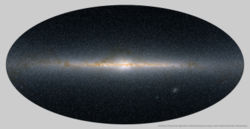
Zone of Avoidance
Encyclopedia

Galaxy
A galaxy is a massive, gravitationally bound system that consists of stars and stellar remnants, an interstellar medium of gas and dust, and an important but poorly understood component tentatively dubbed dark matter. The word galaxy is derived from the Greek galaxias , literally "milky", a...
, the Milky Way
Milky Way
The Milky Way is the galaxy that contains the Solar System. This name derives from its appearance as a dim un-resolved "milky" glowing band arching across the night sky...
.
Term
The ZOA was originally called the "Zone of Few Nebulae" in an 1878 paper by English astronomer Richard Proctor that referred to the distribution of "nebulaNebula
A nebula is an interstellar cloud of dust, hydrogen gas, helium gas and other ionized gases...
e" in Sir John Herschel
John Herschel
Sir John Frederick William Herschel, 1st Baronet KH, FRS ,was an English mathematician, astronomer, chemist, and experimental photographer/inventor, who in some years also did valuable botanical work...
's General Catalogue of Nebulae.
Background
Interstellar dust and starStar
A star is a massive, luminous sphere of plasma held together by gravity. At the end of its lifetime, a star can also contain a proportion of degenerate matter. The nearest star to Earth is the Sun, which is the source of most of the energy on Earth...
s in the plane of the Milky Way (the galactic plane
Galactic plane
The galactic plane is the plane in which the majority of a disk-shaped galaxy's mass lies. The directions perpendicular to the galactic plane point to the galactic poles...
) obstruct our view of around 20% of the extragalactic sky at visible wavelengths
Visible spectrum
The visible spectrum is the portion of the electromagnetic spectrum that is visible to the human eye. Electromagnetic radiation in this range of wavelengths is called visible light or simply light. A typical human eye will respond to wavelengths from about 390 to 750 nm. In terms of...
. As a result, optical galaxy catalogues are usually very incomplete close to the galactic plane.
Modern developments
In more recent years, many projects have attempted to bridge the gap in our knowledge caused by the Zone of Avoidance. The dust and gas in the Milky Way cause extinctionExtinction (astronomy)
Extinction is a term used in astronomy to describe the absorption and scattering of electromagnetic radiation by matter between an emitting astronomical object and the observer. Interstellar extinction—also called Galactic extinction, when it occurs in the Milky Way—was first...
at optical wavelengths, and foreground stars can be confused with background galaxies. However, the effect of extinction drops at longer wavelengths, such as the infrared
Infrared
Infrared light is electromagnetic radiation with a wavelength longer than that of visible light, measured from the nominal edge of visible red light at 0.74 micrometres , and extending conventionally to 300 µm...
, and the Milky Way is effectively transparent at radio wavelengths. Surveys in the infrared, such as IRAS
IRAS
The Infrared Astronomical Satellite was the first-ever space-based observatory to perform a survey of the entire sky at infrared wavelengths....
and 2MASS
2MASS
Observations for the Two Micron All-Sky Survey began in 1997 and were completed in 2001 at two telescopes located one each in the northern and southern hemispheres to ensure coverage of the entire sky...
, have given us a more complete picture of the extragalactic sky. Indeed, two very large nearby galaxies, Maffei 1
Maffei 1
Maffei 1 is a giant elliptical galaxy in the constellation Cassiopeia. It is the closest giant elliptical galaxy to the Milky Way. Once believed to be a member of the Local Group, it is now known to belong to the IC 342/Maffei Group...
and Maffei 2
Maffei 2
Maffei 2 is an intermediate spiral galaxy about 10 million light-years away in the constellation Cassiopeia. Maffei 2 and Maffei 1 were both discovered by Paolo Maffei in 1968 from their infrared emission. Maffei 2 lies in the Zone of Avoidance and is about 99.5% obscured by the Milky Way's...
, were discovered in the Zone of Avoidance by Paolo Maffei
Paolo Maffei
Paolo Maffei was an Italian astronomer and science writer.He was born in Foligno and he has been former director of the Catania Observatory and an astronomer at Arcetri, Bologna, Asiago and Hamburg...
by their infrared emission in 1968. Even so, approximately 10% of the sky remains difficult to survey as extragalactic objects can be confused with stars in the Milky Way.
Projects to survey the Zone of Avoidance at radio wavelengths, particularly using the 21 cm spin-flip emission line of neutral atomic hydrogen
Hydrogen
Hydrogen is the chemical element with atomic number 1. It is represented by the symbol H. With an average atomic weight of , hydrogen is the lightest and most abundant chemical element, constituting roughly 75% of the Universe's chemical elemental mass. Stars in the main sequence are mainly...
(known in astronomical parlance as HI
Hydrogen line
The hydrogen line, 21 centimeter line or HI line refers to the electromagnetic radiation spectral line that is created by a change in the energy state of neutral hydrogen atoms. This electromagnetic radiation is at the precise frequency of 1420.40575177 MHz, which is equivalent to the vacuum...
), have detected many galaxies that could not be detected in the infrared. Examples of galaxies detected from their HI emission include Dwingeloo 1
Dwingeloo 1
Dwingeloo 1 is a barred spiral galaxy about 10 million light-years away from the Earth, in the constellation Cassiopeia. It lies in the Zone of Avoidance and is heavily obscured by the Milky Way...
and Dwingeloo 2
Dwingeloo 2
Dwingeloo 2 is a small irregular galaxy discovered in 1996 and located about 10 million light-years away from the Earth. Its discovery was a result of Dwingeloo Obscured Galaxy Survey of the Zone of Avoidance...
.

